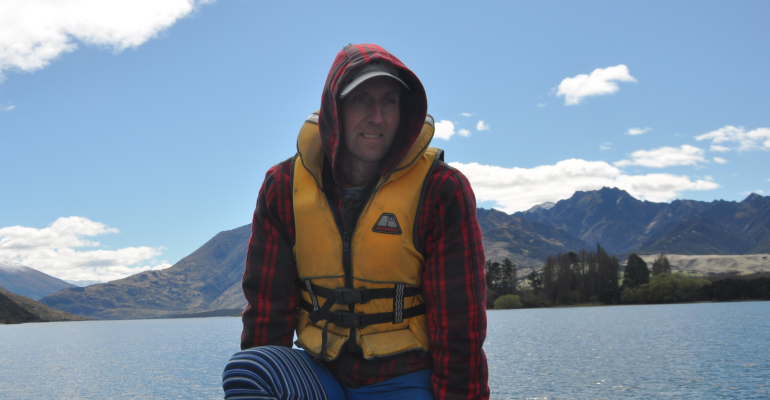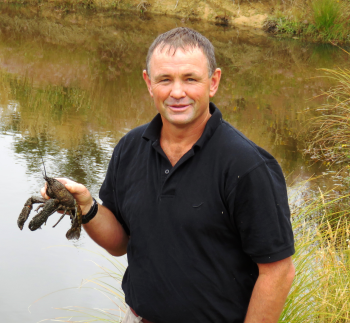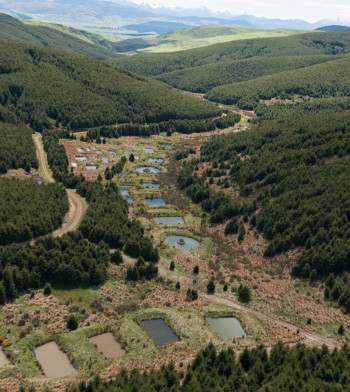Dr Phil Novis
Knowledge boost for freshwater kōura farming. Dr Phil Novis discusses the results of his Seed project to boost New Zealand's slice of the worldwide $9 billion crayfish industry.

“They’re like naughty children, but worse,” says fresh water crayfish (kōura) farmer John Hollows, who manages a kōura aquaculture business within the Ernslaw One forestry estate.
He’s talking about juvenile kōura (craylings) who spend all day trying to rip each other’s pincers off, getting eaten by birds, fish and other pond life, and finding myriad other ingenious ways to get killed.
“They’re really destructive little guys. In the wild, their survival rate into the second year is about 5 percent,” says John.

He’s been working with SfTI Seed researcher Phil Novis to improve those odds. SfTI’s Seed fund is for research that’s exciting, truly novel and perhaps higher risk – the kind that might struggle to find funding elsewhere.
Crayfish is a $9 billion industry worldwide, and the potential for an all-natural, sweet-tasting, fresh-water New Zealand product is huge – but high attrition rates, the geographic challenges of harvesting from hundreds of ponds scattered around South Island forestry blocks and a lack of players has slowed the development of an industry.
Phil’s research has been focused on finding the optimum food source for the kōura in the hopes of improving their survival rates. The idea evolved from an earlier SfTI-funded project in partnership with Awarua Rūnanga and Te Rūnanga o Ngāi Tahu, along with the University of Canterbury. The aim was to explore the very high levels of Eicosapentaenoic acid (EPA) found in a new strain of algae discovered at Awarua, a Southland wetland. If it could be grown commercially, the algae Trachydiscus Awa9/2 could have taken a share of the hundreds of millions of dollars a year being spent on omega-3 fish oil tablets and the like.
That research showed the algae could be grown in the lab, but due to the economics of growth and extraction, the team concluded it would struggle to compete against alternatives such as fish oil at current prices.
John Hollows holds a Master of Zoology and his thesis research had noted that the craylings had access to an important but unknown food source that was thought to be microbial. He’d also observed that adult kōura didn’t seem to do that well on the commercially available pellets that they’re usually fed.
“So we had some hunches to follow,” Phil says.
“The idea to try Daphnia as crayling food came from our partner Rūnanga,” Phil says.
The team pitted several food options against the commercial crayfish pellets – bloodworms, the Trachydiscus Awa9/2 algae, a small water crustacean called Daphnia, and another stock of Daphnia that had been reared on the algae.
“The idea to try Daphnia as crayling food came from our partner Rūnanga,” Phil says.
“We found that the algae wasn’t very good as a kōura food, and they actually do pretty well on the commercial pellets when they’re juvenile,” Phil says.
“So that wasn’t the result we were looking for, but we did find that the algae was an excellent Daphnia feed, far outperforming the use of commercial Spirulina and avoiding the pitfalls of yeast. The kōura fed on Daphnia that had been reared on Trachydiscus Awa9/2 performed just as well as the ones fed on blood worms or pellets,” Phil says.
Daphnia is a small water crustacean. The team found that Daphnia that had been reared on the Southland algae Trachydiscus Awa9/2 provided good levels of Omega 3s to the kōura that ate them“Daphnia are also commercially grown for feeding other species, including aquarium fish, so there’s potential to explore that further.”
The team also discovered some useful things about stocking density. In the experiment, the kōura were stocked at 30 to a tank, based on previous experience, and given plenty of food.
John says the hope was that if provided with enough food and hiding places, the kōura would be less aggressive.
“They were still at each other though, but there was one tank that only had 10 in it, and those guys did a lot better. It was helpful to see that because even though 30 per tank is not the ideal number for stocking levels – 10 is not a bad number either.”

Ernslaw One forestry estate fire break ponds make for ideal kōura growing ponds
Both Phil and John are keen to follow up on this and other advances in understanding brought about by the research.
Phil says moving his research focus to kōura turned up another positive observation about Trachydiscus Awa9/2.
“We had to freeze-dry the algae to transport it to the kōura tanks and when I was using it around a year later, it was still high in Omega 3s and looked like the fresh stuff under the microscope. So we’ve discovered you can grow it in a lab and it’s still potent, and it’s also really shelf stable.”
“From a grower’s perspective, the study’s been well worthwhile,” John says.
“From a grower’s perspective, the study’s been well worthwhile,” John says.
“We’ve learned a lot about the preferred food for craylings, and other aspects of animal husbandry and we’re interested to see how the ones we fed on the Daphnia that were reared on the algae go now we’ve put them back in the wild. We’ll know more on that at the end of next summer, around March 2023.”